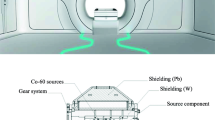Abstract
In 1996, a new γ-ray brain surgical apparatus, the OUR rotating γ-system (RGS), was developed for stereotactic radiosurgery. The device contains 30 cobalt-60 sources distributed in 5 groups along 6 helical lines in a hemispherical primary collimator body, which rotates during treatment together with the built-in secondary collimator body. By rotating the primary and secondary collimator body together, 30 nonoverlapping, full 360° arcs are formed. The 30 cobalt-60 γ-radiation sources have approximately 6000 Ci total initial activity with ≥3 Gy/min initial dose rate at the isocenter. The purpose of this study was to test the geometrical accuracy of this new radiosurgical equipment. The investigations were carried out on Gafchromic Dosimetry Media, Type MD-55 films. Following a pin-prick directed toward the center point of the radiation unit, the films were exposed, and the optical density profiles were analyzed with an automatic densitometer (Molecular Dynamics Personal Densitometer, Model PD SN 50238, Innovative Optical Systems for Biological Research). By measuring the asymmetry of the position of the pin-prick in relation to the density distribution, the geometrical accuracy of the OUR RGS was determined. The calculated difference between the mechanical unit center point and the radiological center point verify the unit of ±0.1054 mm against the generally accepted ±0.5 mm.
Similar content being viewed by others
REFERENCES
Leksell L: The stereotactic method and radiosurgery of the brain. Acta Chir Scand 102:316–319, 1951
Leksell L: Cerebral radiosurgery. Acta Chir Scand 134:585–595, 1968
Leksell L: Stereotaxis and Radiosurgery: An Operative System. Springfield, IL: Charles C Thomas, 1971
Arndt J: Focused gamma radiation. The gamma knife. Quality assurance. In MH Philips (ed), Physical Aspects of Stereotactic Radiosurgery. New York: Plenum Medical, 1993, pp. 121–124
Verhey LJ, Smith V, Serago, CF: Comparison of radiosurgery treatment modalities based on physical dose distributions. Int J Radiat Oncol Biol Phys 40:497–505, 1998
Steiner L, Prasad D, Lindquist C, Steiner M: Clinical aspects of gamma knife stereotactic radiosurgery. In PL Gildenberg, RR Tasker (eds), Textbook of Stereotactic and Functional Neurosurgery. New York: McGraw-Hill, 1998, pp. 763–805
Smith V, Verhey L, Serago CF: Comparison of radiosurgery treatment modalities based on complication and control probabilities. Int J Radiat Oncol Biol Phys 40:507–513, 1998
Goetsch SJ, Murphy BD, Schmidt R, Micka J. De Werd L, Chen Y, Shockley S: Physics of rotating gamma systems for stereotactic radiosurgery. Int J Radiat Oncol Biol Phys 43:689–696, 1999
Author information
Authors and Affiliations
Rights and permissions
About this article
Cite this article
Szeifert, G.T. Geometrical Accuracy Test Obtained on the OUR Rotating γ-System. Journal of Radiosurgery 2, 181–188 (1999). https://doi.org/10.1023/A:1022926915354
Issue Date:
DOI: https://doi.org/10.1023/A:1022926915354




